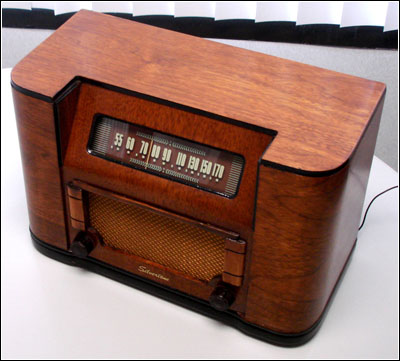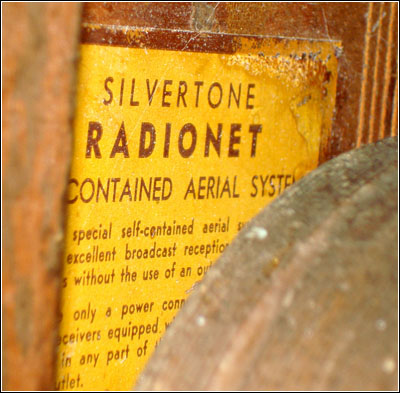Of Old Radios And Related Items--Published Monthly
The Silvertone Saga
Who Wants an Old Tube Radio Anyway?
BY PAUL BURESH
Web Edition
Learning how a radio collector first became attracted to old radios is always an interesting part of the hobby. Paul Buresh tells us how he got hooked. (Editor)
A long time ago I resolved that I would write the story about how I got involved in collecting radios. Radio has always been in the background of my life. When I was a child growing up during the 1960s and 1970s, the kitchen radio was always on. Before everyone had a TV in every room and before the advent of cable, radio was a primary source of entertainment and news. My parents had a very nice "Realistic" radio in the kitchen, and it was something I always remember when I think of the house where I grew up. But, a Silvertone figures even more prominently in my story.
Early Life of the Silvertone
I had a great uncle who passed away when I was about 14 years old, and in the process of cleaning out his home, I came upon the old Sears Silvertone Model 7134 wooden table radio, shown in its restored state in Figures 1 (see print version) and 2. I thought it was too good-looking to simply throw away, even though I had some doubts as to whether it would work.
I plugged it in at home and heard hiss and static. What a bummer! My father, who was truly from the radio generation, had obviously seen this type of thing happen before and told me he thought it could be repaired.
My father took me to see a friend of his who was not only a mechanic but also a TV and radio repairman.
Figure 2. The interesting style of my Silvertone radio is shown in this oblique view.Apparently "Johnny" had been a radio operator in World War II and had become adept at repairs as well. He took me down to his shop and performed a little magic, tested the tubes, replaced a couple of them, and charged me two dollars.
I was back in business. After a brief warm-up the Silvertone came to life. It did not sound like the other radios I had heard. It had a softer, warmer sound than I had been used to. Sometimes it squealed a little when tuning and picking up a signal it could not quite decipher.
To my delight it picked up more stations than I was aware existed. From Dedham, Massachusetts, I was able to receive New York City stations almost every night. Jean Shepard became a regular show for me. I could listen to Ernie Harwell on WJR in Detroit broadcast the Tigers games. I pulled in Cleveland, Philadelphia, Baltimore, all with pretty good regularity.
Some nights the reception was better than others, but there was always Larry Glick on WBZ in Boston on nights when the other cities did not come in. CBS Mystery Theater with E.G. Marshall was another great show to listen to on the Silvertone. Little did I know that Himan Brown who produced the Mystery Theater was the same person who produced Inner Sanctum. All I knew was that I liked to listen. Even the Red Sox seemed to play a little better when I listened to the game on my Silvertone.
I became interested in DX and shortwave and picked up a solid-state Grundig and Sony and began not to listen so much to the Silvertone. The Silvertone was furniture again, as other diversions took its place. I took it with me when I moved because it was too good-looking to simply throw it out. I plugged it in one night and got static and hiss, I picked up WBZ and then it faded to hiss. The Silvertone went down to the basement.
Figure 3. A portion of the "Radionet" loop antenna can be seen on the upper right section of this photo, along with a portion of the label extolling the benefits of the self-contained aerial system.Later Life of the Silvertone
I got married, we adopted a son, many years passed, and the Silvertone was still in the basement. When I had a little time one day, I cleaned it up, but I didn't like the scratches on the top, the thing did not work -- why should I even keep it?
I had seen an article about a guy in Connecticut who fixed up old radios. In the article he said, "They're beautiful things; don't underestimate the strength of the straightforward electronics of that era." I decided he was right; someday I would pay him a visit.
On a brisk March day, I took a friend with me, and we took a drive to see Bob Eslinger at Antique Radio Restoration and Repair, http://oldradiodoc.com. My friend Jerry had a father who was an active Ham, an all-around extreme radio enthusiast. I thought Jerry would understand why someone would fix an old wood radio and probably get a kick out of seeing a guy who did that for a living.
We showed up in "radio heaven," or maybe it would be better put to say, "the land of radio resurrection" -- maybe it is both. Bob looked over the Silvertone, and I heard, "uuuhhh and mmmm," just like what you might hear from a doctor. He said it was from the late 1940s, a 6-tube set, with an antenna inside. A glimpse of the loop antenna and its label is shown in Figure 3. He said it should sound great with an overhaul; it was not too far gone. The cabinet could be redone as well. I left the Silvertone with Bob.
With a little research, I figured out it is more than a Sears Silvertone. It is a Sears Silvertone Model 7134, Chassis #110.448, shown in Figure 4 (see print version). The tube complement is 12SQ7, 35L6GT, 12SK7, 12SA7, 35Z5GT, 12SK7. It was produced in Brooklyn, New York, by the Air King Radio Corporation, probably in 1946. Who even knew they made radios in New York? It was the best thing out of Brooklyn since the Dodgers.
A while later, the job was done, and the cabinet looks better than it probably did brand new. It sounded great. It was safe to play again, and I was back in business. Old radios were really interesting again. Who knew that these old things could sound so good and last so long? Who knew they could pick up all these long distance signals, and who knew that an old wood radio was still worth listening to? I did -- I had just forgotten.
Say, do you know where I can get an old Zenith AM//FM set?
Though always interested in radio and radio equipment in the past, Paul Buresh's interest was renewed with the restoration of the Silvertone. RCA and Zenith sets comprise most of his modest collection; however, his largest set is a Stromberg-Carlson 430 console, while the smallest is a Wells Gardner midget set. His most recent acquisition is an Airline 62-425 from 1936 found in Maine. His wife and son think he has too many radios!
|
[Free Sample] [Books, etc., For Sale] [Subscribe to A.R.C./Renew] [Classified Ads] [Auction Prices] [Event Calendar] [Links] [Home] [Issue Archives] [Book Reviews] [Subscription Information] [A.R.C. FAQ]URL = http://www.antiqueradio.com/Oct09_Buresh_Silvertone.html Copyright © 1996-2009 by John V. Terrey - For personal use only. Last revised: September 30, 2009. For Customer Assistance please contact ARC@antiqueradio.com or call (866) 371-0512 toll free Antique Radio Classified |

